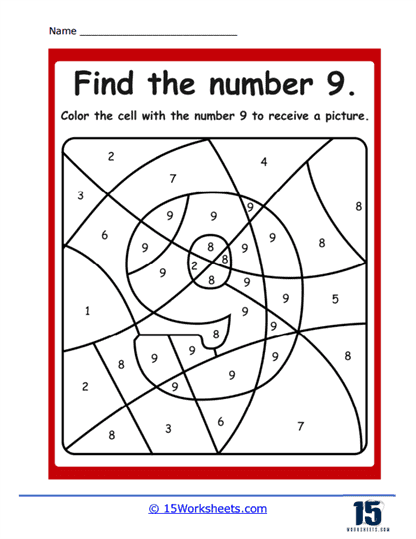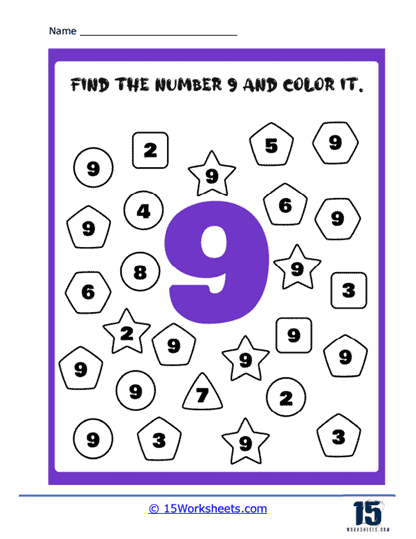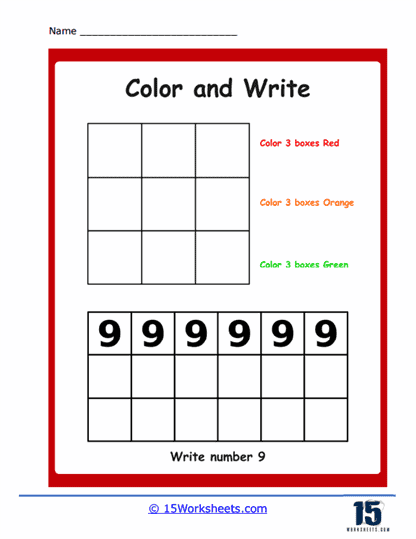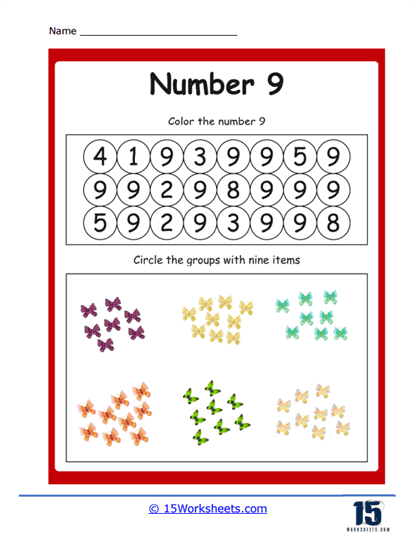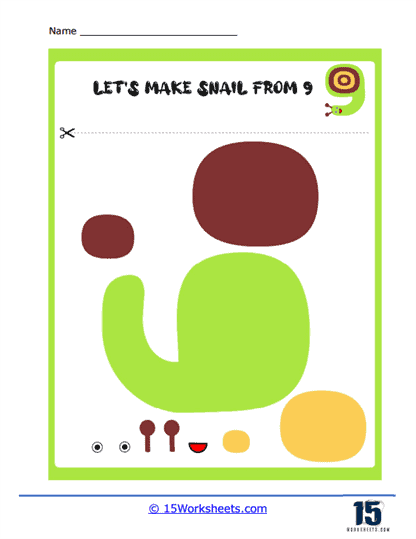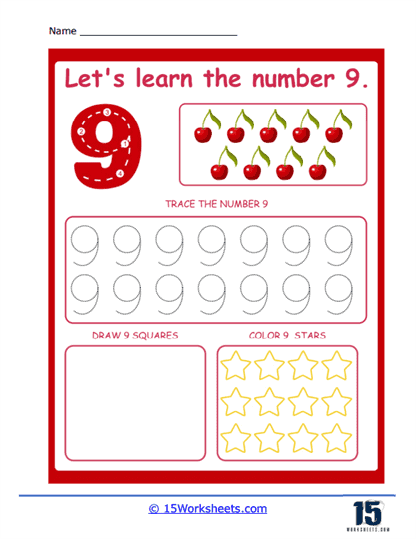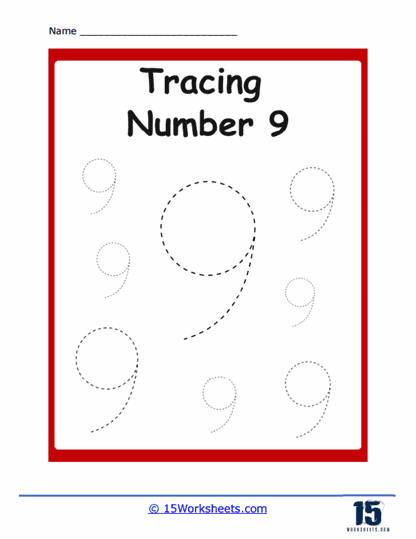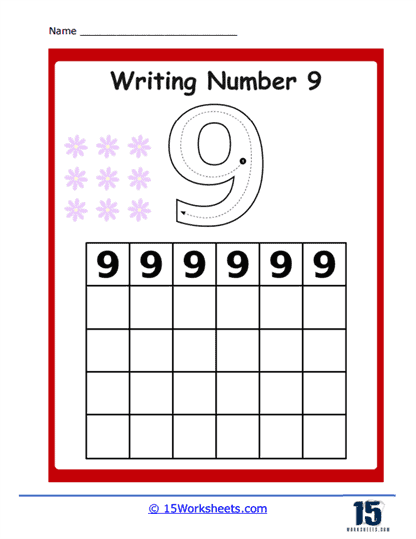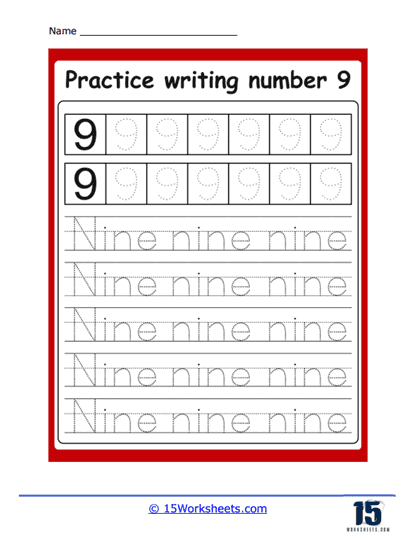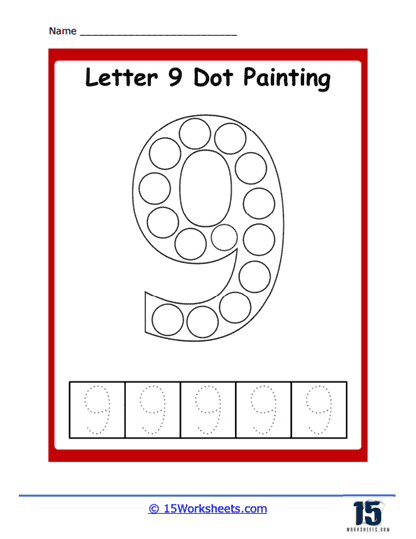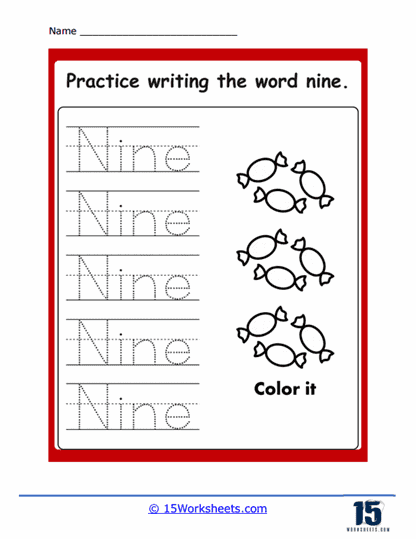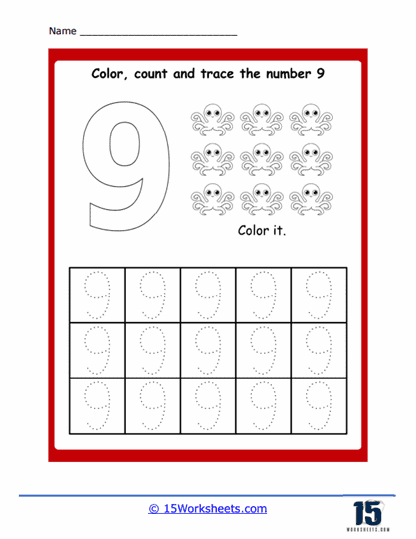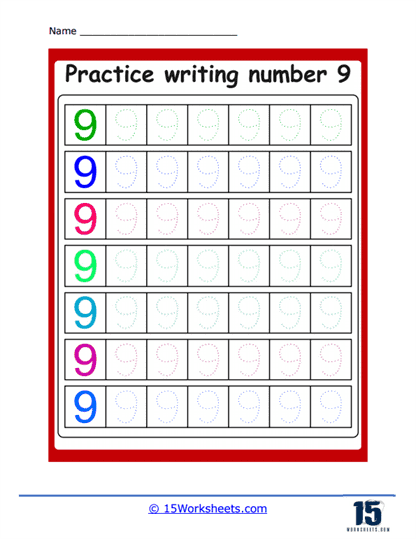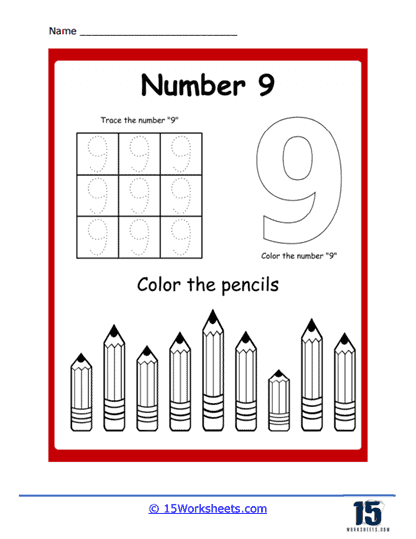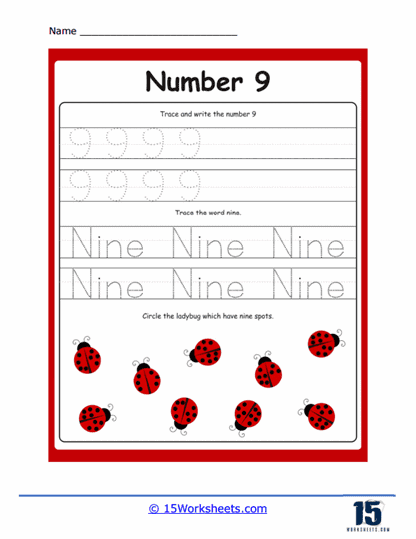Number 9 Worksheets
About These 15 Worksheets
Our meticulously crafted number 9 worksheets are designed with young learners in mind, offering them the foundational tools they need to not only learn but also master the concept of the number 9. These worksheets go beyond simple exercises; they are thoughtfully structured to engage children’s minds through a variety of activities that foster recognition, writing, and a deep understanding of this essential number. Whether through tracing, coloring, counting, or matching, each activity is carefully chosen to nurture a child’s numeracy skills while keeping the learning process enjoyable and interactive.
At the heart of this series is the tracing activity, which serves as the perfect introduction for young learners to get comfortable with the number 9. Presented both as a numeral “9” and in its written form, “nine,” the activity helps children connect the symbolic representation with its linguistic counterpart. This dual approach is crucial for their cognitive development, as it strengthens their ability to recognize and associate the number in multiple contexts. Tracing along the dotted lines encourages fine motor skills development, reinforcing the muscle memory necessary for writing the number on their own. As they trace, children not only practice the physical act of writing but also begin to internalize the form and significance of the number 9, making it a familiar and intuitive part of their numerical vocabulary.
Following the tracing activities, we introduce vibrant coloring tasks, where children are invited to color in sets of nine objects-perhaps nine apples, balloons, or stars. This seemingly simple task holds much more value than meets the eye. By coloring exactly nine items, children begin to form a tangible connection between the abstract idea of the number and a concrete quantity. It’s one thing to know that the number 9 exists, but it’s quite another to understand that it represents a collection of nine distinct items. This understanding is a key milestone in early numeracy, and coloring helps to anchor this concept in a child’s mind, all while allowing them to express their creativity and further enhance their hand-eye coordination.
Another essential component of our worksheets is the counting exercises, where children are encouraged to identify and count groups of objects. These exercises are deliberately varied to keep young learners engaged while steadily building their ability to count accurately. For instance, a child might be presented with an array of objects-some groups containing more than nine, others fewer-and tasked with identifying which group has exactly nine items. Such activities challenge children to apply their counting skills in real-world scenarios, solidifying their understanding of the number 9 as a fixed quantity. The process of counting and verifying also promotes critical thinking and attention to detail, which are invaluable skills in all areas of learning.
Matching activities take this understanding one step further by reinforcing the link between the written number and the quantity it represents. In these exercises, children are asked to match groups of objects with their corresponding numeral, or sometimes even the written word “nine.” This activity is an excellent way to enhance number recognition, as it engages the brain in actively connecting symbols with real-world quantities. It also fosters an early sense of pattern recognition, as children begin to see relationships between numbers and quantities in different forms. This kind of mental association is a cornerstone of mathematical thinking, helping children to recognize that numbers are not just abstract symbols, but tools used to describe the world around them.
In addition to these foundational exercises, our worksheets also introduce basic addition and subtraction problems involving the number 9, such as 5 + 4 or 9 – 0. These problems are carefully selected to gently introduce children to mathematical operations, building a bridge between simple number recognition and more complex arithmetic skills. By practicing these operations, children not only begin to grasp the concept of addition and subtraction but also develop problem-solving skills that are critical to their overall cognitive development. Early exposure to these operations prepares them for the challenges of more advanced math in the future and nurtures a sense of confidence in their ability to tackle mathematical problems.
The importance of these worksheets in early childhood education cannot be overstated. At a fundamental level, they provide young learners with the building blocks of numeracy. Mastery of the number 9 and indeed, any number requires more than just rote memorization; it involves developing an intuitive understanding of what that number represents. Recognizing, writing, and understanding the number 9 is a crucial part of early mathematical learning, as it forms the basis for future mathematical concepts such as place value, addition, subtraction, and multiplication. These worksheets serve as a bridge from the abstract concept of numbers to their practical application, making the idea of “nine” something a child can see, touch, and understand.
The sheer variety of activities in these worksheets ensures that they cater to a range of learning styles, making them both inclusive and highly effective. Visual learners benefit from seeing the number and its representation through objects, strengthening their ability to visually process information. Auditory learners can benefit from hearing instructions or engaging in discussions about the number 9. Kinesthetic learners, who learn best through hands-on activities, thrive in the physical act of tracing, writing, and manipulating objects to count or match. This multi-sensory approach ensures that every child, regardless of their preferred learning style, has the opportunity to grasp the concept of the number 9 in a way that makes sense to them.
Why Is The Number 9 Unique?
The number 9 holds a distinctive place in the world of mathematics, capturing attention for its remarkable and almost magical properties. While every number has its own set of interesting characteristics, 9 stands out due to its deep connection with patterns, symmetry, and the fundamental structure of our numerical system. From elementary school classrooms to advanced mathematical theorems, the number 9 plays an integral role in shaping our understanding of numbers. Here are several compelling reasons why this number deserves special recognition.
Multiplication
One of the most captivating features of the number 9 is its behavior in multiplication. No matter what number you multiply by 9, when you sum the digits of the product, you will always arrive back at 9. This is not just a neat trick-it’s a consistent and reliable pattern, a reminder of the cyclical and interconnected nature of numbers. Consider 9 multiplied by 5: the result is 45, and when you add 4 and 5, you get 9. Another example is 9 x 13, which equals 117. Adding the digits 1, 1, and 7 also leads you back to 9. This property holds true for any number, no matter how large or complex, reinforcing the idea that 9, in a sense, always returns to itself. It’s as if the number 9 has an inherent ability to draw everything back into its orbit, demonstrating a fascinating numerical harmony.
The Digital Root Phenomenon
Not only does 9 exhibit special properties in multiplication, but it also plays a curious role in addition. When you add 9 to any number, the digital root of the sum will always be the original number. This might seem mysterious at first, but it’s another instance of 9’s unique presence in our number system. Take the number 5: if you add 9 to 5, you get 14. Now, sum the digits of 14-1 and 4-and you’re left with 5, which is exactly where you started. This pattern continues with every number you add to 9, offering a satisfying sense of consistency and structure in what might otherwise seem like simple arithmetic.
Finger Math
In classrooms around the world, teachers often introduce the number 9 with an ingenious finger trick that makes multiplying by 9 not only easier but fun. If you number your fingers from 1 to 10 and then fold down the finger corresponding to the number you’re multiplying by 9, the remaining fingers give you the answer. The fingers to the left of the folded finger represent the tens place, and those to the right represent the ones place. For instance, if you want to multiply 9 by 4, fold down your fourth finger. To the left of the folded finger are 3 fingers (representing 30), and to the right are 6 fingers (representing 6). The answer is 36. This delightful trick adds to the sense of wonder surrounding the number 9, making it accessible and memorable even to young learners.
A Tool for Accuracy
The number 9 also plays a crucial role in a method called “casting out nines,” which serves as a quick way to verify arithmetic operations. Whether you’re adding, subtracting, multiplying, or dividing, casting out nines helps to check the accuracy of your calculations by reducing numbers to their digital roots and ensuring that the results make sense. This technique has been used for centuries and is still taught today as a way to catch errors in large or complex calculations. Once again, 9’s special relationship with patterns and consistency is on full display, making it a helpful tool in mathematical problem-solving.
Geometry and Symmetry
Interestingly, the number 9 also finds a place in the realm of geometry. If you divide a 360-degree circle into sections of 40 degrees each, you get exactly 9 equal parts. This division reveals an elegant connection between the number 9 and spatial symmetry, reinforcing its presence not only in numbers but also in shapes. Furthermore, the number 9 itself is visually symmetric when you draw it-it mirrors itself along a vertical axis. Even more intriguingly, when rotated 180 degrees, the number 9 becomes a 6, highlighting its dual nature. This connection between numbers, geometry, and symmetry elevates 9 to a special status, not just in arithmetic, but in the broader study of mathematics and design.
Base-10 System
As the highest single-digit number in our base-10 number system, 9 holds a position of both finality and potential. It represents the culmination of single digits before transitioning into the next tier of numbers-10 and beyond. The base-10 system is the foundation of most modern numerical calculations, and within this system, 9 acts as the threshold between simplicity and complexity. Its placement at the edge of single digits further contributes to its mystique, as it is both the end and, in many ways, the beginning of a new numerical journey.
The Repeating Nature of 9
Another fascinating feature of 9 is found in the recurring decimals produced when dividing 1 by 9. The result is 0.1111… continuing infinitely. Similarly, 2 divided by 9 is 0.2222…, 3 divided by 9 is 0.3333…, and so on, all the way to 8/9, which equals 0.8888…. This predictable repetition highlights the rhythmic nature of numbers and their intimate ties with patterns. However, when you divide 9 by 9, the answer is 1, completing the cycle and restoring balance. This repeating nature of 9 further deepens its relationship with infinity, symmetry, and structure.

